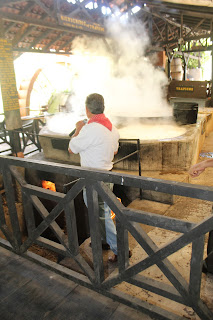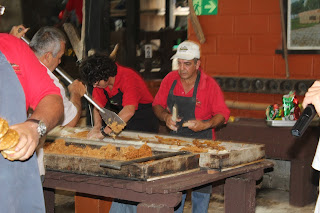The candy was made from sugar cane which was pressed and squeezed until the sugary liquid was expelled.
The liquid was then poured into large vats ready for boiling down into a syrupy liquid.
The vats were heated underneath by the leaves and stalks of the sugar cane so nothing went to waste.
As the juice boiled down it was topped up from another vat.
When the liquid reached a certain point, a helper scooped some of the liquid into a plastic cup and then added lemonade to make a very sweet drink. Gary and I were the only non-natives observing the candy making so the helper brought the drink over to Gary for him to try. Because Gary is diabetic he handed the drink to me after taking a small sip. I reluctantly put my lips to the cup and took a drink and was pleasantly surprised. It was sweet but not as sweet as I thought it would be.
The candy making process continued. The vat now boiled down to a specific consistency and the contents poured into 2 separate areas ready for making three types of candy. Whilst the vat was being emptied a helper scooped up the boiling liquid and immediately plunged it into a bucket of water. The result was a very sticky, stretchy goo.
The helpers went around giving out samples of the goo. When I took mine and placed it in my mouth, it nearly locked my teeth together because it was so sticky. This made Gary eager to buy some of the goo!!! The taste was pleasant. They continued to sample the mix until it hardened enough to break when tossed onto a board. It was then ready to be made into candy. Three separate types were made. The goo was spread into a large container and onto the sides of a concrete water tank where it was left to cool.
The goo was then sprinkled with peanuts chopped up very small and then rolled into two big balls and joined together to make one large ball.
This was then taken to a wooden post with a hook about 5 feet from the floor and then pulled into a strip, put back onto the hook and the process started again. This must have gone on for at least 15 minutes before being taken off the hook and placed on a table.
After 15 minutes the stretched "candy" was taken to a table, rolled in chopped peanuts and into a long sausage shape and chopped into 1" pieces.
The finished candy was then handed out to the spectators and offered for sale. I did not mind the sticky stuff but I did not like the finished candy so I did not purchase any.
The other batch of liquid from the vat was poured into a wooden trough and stirred for about 15 minutes whilst it thickened and changed color.
The thickened liquid was then poured into wooden holes and left to cool.
Unfortunately, we never saw what happened to above "candy".
The grounds of the candy making demonstration were very nice. There was a small lake with 3 ducks on it. Two of the ducks looked like they had pompoms on their heads.
As you can see when I tried to take a photo of the two ducks, one of them ducked his head under the water.
There was a second lake minus ducks but with a nice view.
We had seen coffee being made in Hawaii but wanted to see if coffee from Costa Rica was any different as pure Costa Rican coffee is supposed to be very good.
The guide spoke good English which made the tour more enjoyable as there was no English spoken at the candy making. She started off by showing us coffee seedlings and the different stages the plant goes through before it reaches maturity.
Apparently, coffee bushes can produce coffee from about 5 years to almost 100 years but after about 25 years the quality declines and this estate replants new bushes.The coffee is picked when the berries are red and put into a laundry basket worn around the waist.
It is hard work as the berries have to be hand picked and if the worker has too many green berries in their basket they will not get paid. The plantation usually provides housing for the workers so there is some incentive to be a coffee berry picker.
After picking, the berries are weighed and dumped into a water tank to separate the good berries from the bad. The good berries will sink and make the better coffee.
Two percent of the berries will have abnormal beans called peas. These are ones where a larger half receives all the nutrients and becomes round. These peas are considered the very best of the beans. The rejects will become a cheaper grade of coffee. They are sorted by size, ending up with three grades of coffee. The berries then go to a grinder to remove the outer casing of the berry to reveal a very small white bean.
All the machinery is run by water power, which drives a long shaft running above the machinery. The machines are powered by long belts driven off the shaft. The Doka Estate is the oldest water powered coffee plantation in Costa Rica. The beans are then sent to a fermenting tank where they will remain for 36 hours.
The beans still have a protective husk at this point. The beans are then laid out in the sun to dry on concrete and have to be raked and turned every 45 minutes during the day.
At night they are covered with plastic to prevent them from being spoilt by the humidity. The beans stay in the sun for 5 days unless it rains. If it does rain it prolongs their stay in the sun. There is a large mechanical dryer available but this is not the preferred method. After drying, the pea beans are separated from the best graded beans. The last step is to remove the husks. The beans are stored in burlap sacks for 3 months. After 3 months, the beans are mostly shipped out. Only 3% of the total output stays in country and it is the poorest quality that stays. The beans only have the coffee smell after being roasted which often takes place elsewhere. Coffee varies by the length of time roasted, as well as the mix of quality of beans. It is then called blended coffee. To get French Blend it is roasted for 17 minutes at 250C.
The plantation was surrounded by beautiful hydrangeas with heads bigger than Gary's hand.
I took another photo of a weird looking flower but do not know the name of the plant.
So ends a very educational and enjoyable day. I think I will go home and have a cup of coffee!!!




























No comments:
Post a Comment